Calling Big Bulls!
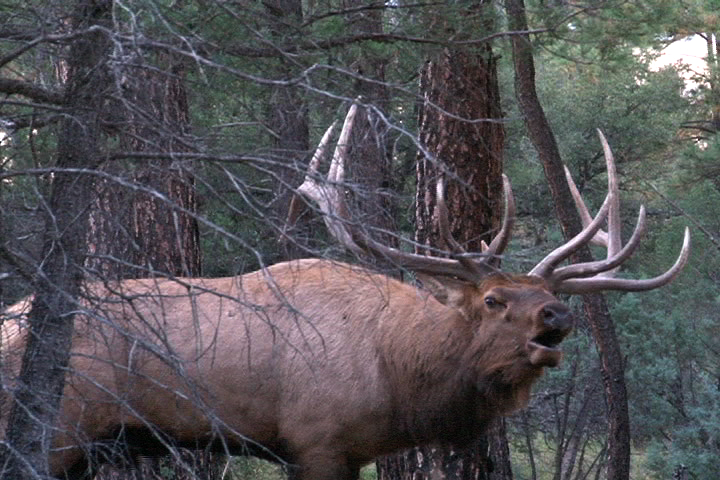
It is awesome to think that we are about a month away from the start of the rut. What a magical, unforgettable time of year it is! I can distinctly remember the first time I called a bull in and shot him with my bow on that aspen choked hillside back in the early 90’s. I vividly recall drawing back on the bugling bull and having all my pins on his lungs thinking, “Wow, that was easy. Why didn’t I learn to call years ago”!
While it wasn’t my first bull elk kill, that call in encounter with that unsuspecting 5×5 changed my life forever. I remember well the drive home, with my bull in the bed of the truck, and having an overwhelming sense of accomplishment flood over me. The feeling was so strong and undeniable that I was determined to relive that feeling every year from that point forward.
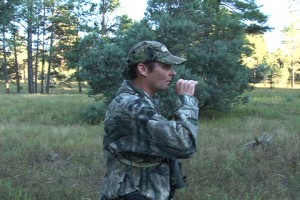 Looking back now on that encounter makes me realize that while I have significantly refined and improved my calling that I actually haven’t changed much in my approach to calling bulls in.
Looking back now on that encounter makes me realize that while I have significantly refined and improved my calling that I actually haven’t changed much in my approach to calling bulls in.
That morning, on the mountain hillside, I had the wind in my face, I got fairly close to the bull before setting up, picked a good spot with multiple shooting lanes, and called the bull in with what I thought were sweet cow calls on my mouth reed. Even though I was “green”, it worked just like I’d seen Wayne Carlton do it on his videos.
These days with close to 20 years of calling under my belt do I have any real secrets? To be honest, I wouldn’t necessarily say that I do. Growing up as an athlete who loved sports, I’ve always observed that in sports, those who always adhere to the basics and do them well succeed to the highest degree. The best basketball players have a “pure” shot, and handle the ball well to create open shooting opportunities for themselves. So how does this relate to calling elk?! For me it relates well because I take the basics of calling and apply them every time for consistent results.
Here are what I consider the basics of elk calling;
Always hunt with the wind right
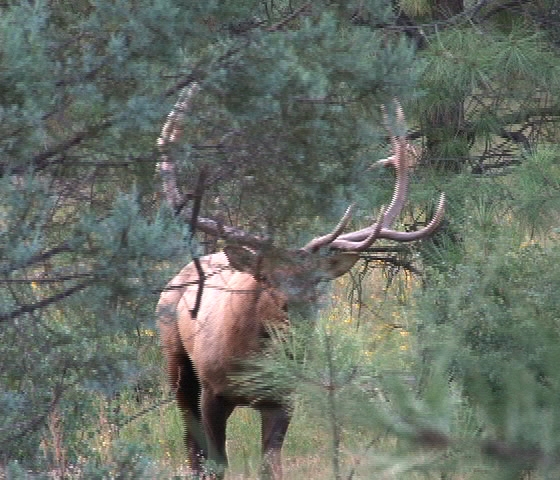 I always carry a wind checker and use it a lot! No matter how particular you are about scent, a hunter should never ignore the wind. I also strive and make the extra effort to setup on bulls with the wind so much in my favor that it is hard for a bull to easily circle and get my wind. If you make it easy for them to divert to your downwind side before coming in, they will. Over 90% of the bulls that I call in come straight at me rather than circling down wind, because I make it very hard for them to do so. Wind checkers are cheap. Next to my elk calls, this my most important item for calling elk.
I always carry a wind checker and use it a lot! No matter how particular you are about scent, a hunter should never ignore the wind. I also strive and make the extra effort to setup on bulls with the wind so much in my favor that it is hard for a bull to easily circle and get my wind. If you make it easy for them to divert to your downwind side before coming in, they will. Over 90% of the bulls that I call in come straight at me rather than circling down wind, because I make it very hard for them to do so. Wind checkers are cheap. Next to my elk calls, this my most important item for calling elk.
Get close to a bull before calling to him
I’ve found that elk typically have somewhere they are intentionally going to. The more in synch I am with their direction of travel, the better my chances are of them coming to my call. Think of it this way. If an elk is moving from his nighttime feeding and watering area and is enroute to his bedding area, it makes sense that he would more readily veer from his route 100 yards than he would 800 yards. Setting up and calling from too far away used to be my most common mistake. I have occasionally called bulls from over 800 yards away, but these have mostly been smaller satellite bulls. The bigger mature bulls seem to respond much better the closer and more convenient I am for them.
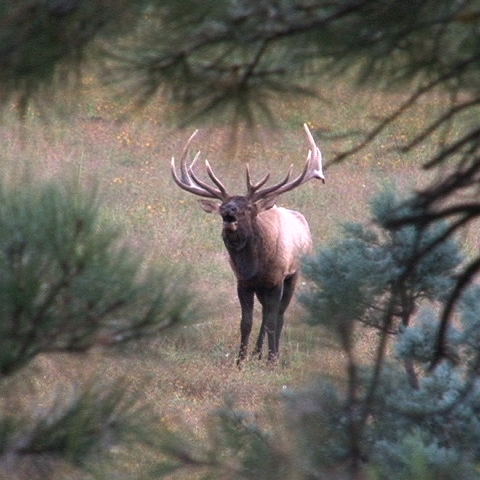 If I am calling for myself, I am careful to pick setups where the bull is forced to walk into my archery range before he can actually see my calling position. I can’t overstate how important this is! So if I am hunting in Pine country I will use small ridges, draws or rolls in the terrain to my advantage when picking a setup. If I am on the level with the bull he can simply look 100- 200 yards ahead and see that there is no elk there and hang up. Decoys can help with this, but I’ve found that mature bulls will oftentimes stand back, watch, and expect the decoy to show a little life before committing. For this reason I much prefer to hunt thicker vegetation such as Pinion Juniper or Cedar country. In the high mountains, spruce or areas of thicker vegetation would be preferred over more open aspen groves.
If I am calling for myself, I am careful to pick setups where the bull is forced to walk into my archery range before he can actually see my calling position. I can’t overstate how important this is! So if I am hunting in Pine country I will use small ridges, draws or rolls in the terrain to my advantage when picking a setup. If I am on the level with the bull he can simply look 100- 200 yards ahead and see that there is no elk there and hang up. Decoys can help with this, but I’ve found that mature bulls will oftentimes stand back, watch, and expect the decoy to show a little life before committing. For this reason I much prefer to hunt thicker vegetation such as Pinion Juniper or Cedar country. In the high mountains, spruce or areas of thicker vegetation would be preferred over more open aspen groves.
Regardless of where I am hunting my rule of thumb is this. I try to close every bit of distance that I can between myself and the bull before setting up. If I can move forward 10 more yards to the next little pocket of trees to setup- I will! Then I try to place some sort of obstacle between me and the bull (usually trees). That way he must continue coming and searching for the call until he walks into one of my lanes! With close setups your calling realism becomes important. That brings us to point #3.
Listen to real elk and practice calling a bunch
 It just stands to reason that the more “elk like” a hunter sounds on the calls, the more bulls he/she will call in. Calling truly is about a mindset and confidence. If you practice 300 days a year on mouth diaphragms and good open reed calls for 5 to 10 minutes – you will be amazed at how it will impact your calling success. Even 100 days of practice is better than buying a “push” call on the way out of town and expecting every bull on the mountain to run to it.
It just stands to reason that the more “elk like” a hunter sounds on the calls, the more bulls he/she will call in. Calling truly is about a mindset and confidence. If you practice 300 days a year on mouth diaphragms and good open reed calls for 5 to 10 minutes – you will be amazed at how it will impact your calling success. Even 100 days of practice is better than buying a “push” call on the way out of town and expecting every bull on the mountain to run to it.
This may surprise some, but I’m not at all about defining or understanding what every elk sound exactly “means”. That just confounds and confuses the issue! What is more important is recognizing the “intensity” in the call. The more time you spend in the field with elk, the better you will recognize the varying degrees of intensity in their calling- that’s the key. My success has come from putting proper elk tone and emotion into my calls. That will come to you by closely listening to what real elk sound like and practicing to copy the tone and emotion in their calls. Over the years with this approach and mindset, cow calling with the proper emotion has worked incredibly well for me to call many great, mature bulls in.
I know that some guys consistently call bulls in with bugling. This makes perfect sense as well, because when I hear them bugle they hit a strong, aggressive, high pitched note that sounds like a bull. So when they get close and bugle at a bull, their tone and intensity matches and is natural. This causes the bull to come in angry, looking for a fight. They also hunt with the wind right, and get close before setting up as opposed to bugling at a bull with cows from 300 yards away, which most often sends the bull running off with his harem.
My One Exception
In the last few years the only variation in my calling has been the addition of cow estrus calls to my calling sounds. There is some debate about whether this sound is a true estrus sound, but like I mentioned, I’m not trying to “define” every elk sound. I learned this sound by hearing real cows make it. I’ve heard it in the summer and in the fall, but during the rut the call is more demanding and emotional and the bulls react to it big time.
Please don’t be confused by this, I don’t use this sound very often. When I do though, I will make the sound often, loudly, and somewhat randomly as I am walking. What I am trying to duplicate is a hot cow that is alone and cruising. She’s being loud and aggressive about her desire to meet a bull and have her fire quenched! The sound works very well for me in the evenings when the bulls are sluggish and don’t want to bugle. This call really gets their attention, gets them bugling, and most importantly- they get fired up and come to me. My cousin and I have a special code name for this call that I shouldn’t repeat here.
I hesitate even bringing up this sound because I don’t want to complicate elk calling at all. 99% of my success over the past two decades has come from simply doing the basics well that I’ve covered and by blowing “sweet” cow calls- nothing more.
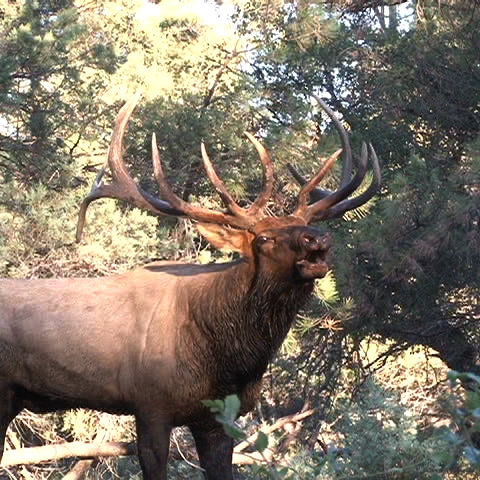 Elk calling doesn’t have to be rocket science. God created elk with great instincts- rather than good reasoning ability like we have. Sometimes we hunters tend to mistakenly ascribe human thought processes to a bull elk when they aren’t that complicated. My friends and I call that R & D- “Too much research and not enough development”. By keeping calling basic and not over thinking it, you will be much less confused and frustrated and way more successful- I promise.
Elk calling doesn’t have to be rocket science. God created elk with great instincts- rather than good reasoning ability like we have. Sometimes we hunters tend to mistakenly ascribe human thought processes to a bull elk when they aren’t that complicated. My friends and I call that R & D- “Too much research and not enough development”. By keeping calling basic and not over thinking it, you will be much less confused and frustrated and way more successful- I promise.
Execute the basics well and enjoy that first call-in or your 1,000th! Whatever it is I hope it changes your life like it has mine;)
